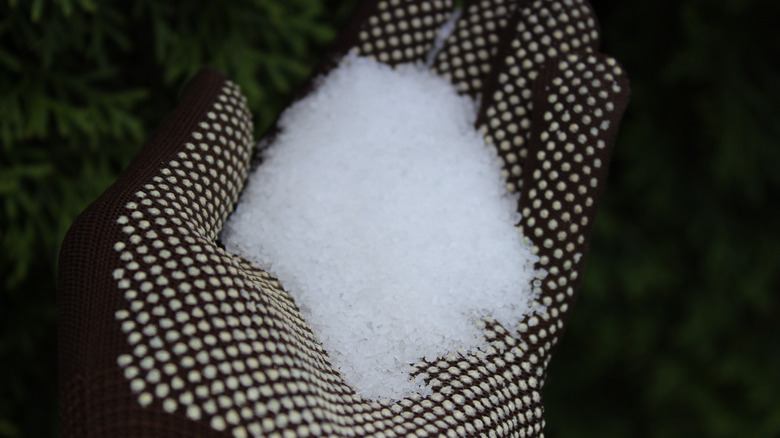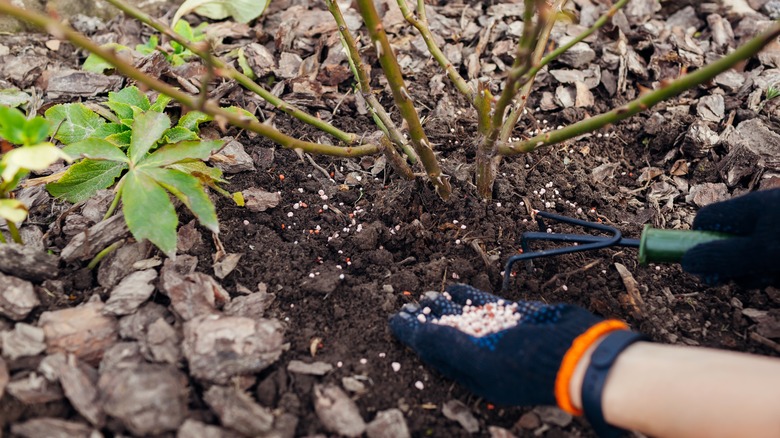Roses are arguably one of the most revered flowers of all time — with numerous references in history and even symbology. It’s no wonder why homeowners who tend gardens like to add this bush to their collection, not just for its beautiful petals — but also for the bragging rights. However, the luster of those red, white, or pink flowers can quickly fade or dwindle if they’re missing the necessary nutrients. Because a thick bush full of radiating flowers is the goal, you can offset a dull blooming season with a common household item: Epsom salt. Epsom salt is made of magnesium sulfate, a compound that could ensure your roses stay thriving.
When there is a lack of magnesium in the soil, your rose bush can suffer discoloration on the leaves. They turn yellow at the edges and stay green in the middle. This is because magnesium and sulfur are required for chlorophyll production, enzyme activation, and nutrient uptake. Without them, leaves turn yellow, which impacts their ability to photosynthesize, and the rose plants become more susceptible to disease. In turn, this leads to stunted growth of the rose bush and a disappointing flower yield. Epsom salt is recommended to be added to the soil as a booster in order to combat the lack of these two nutrients and give your roses the facelift they need.
Sprinkle Epsom salt at the base of the rose bush and water

In order to use this hack, you’ll first need to determine whether or not your plants actually need Epsom salt before applying it. This involves testing the soil for its magnesium, sulfate, and pH levels and checking if the bush displays any signs of sickness or disease. If your soil pH is too alkaline, that indicates that it could stand to have some Epsom salt. The sulfur would lower the soil pH, balancing it out. Roses thrive in neutral soil, so if the soil is too acidic, you know that adding Epsom salt would only make things worse.
Additionally, check the leaves of your rose bush for signs of yellowness that point to a sulfur deficiency. Magnesium deficiencies cause interveinal chlorosis – where the leaf edges turn yellow while the veins stay green. If you’ve done a once-over and decided that your rose bush could benefit from a little sprinkle of Epsom salt, then grab a measuring cup and the salt. Measure ¼ cup of Epsom salt, add it to the soil around the rose bush, and mix it properly. Make sure you water the roses generously after this to allow the salt to dissolve. Do this two or three times a year for the best results.
Don’t substitute Epsom salt for fertilizer

Using Epsom salts is a suitable method for reintroducing magnesium and sulfur into the ground to promote your rose bush’s health and growth — but it should not be used as a substitute for fertilizer. Fertilizer is professionally balanced and contains the ideal ratio of elements for the soil. There is such a thing as overdosing your garden on Epsom salt, which is why tests should be carried out to ensure that your plant actually needs it. Adding too much to the plant can lead to leaf scorch, where the leaves turn brown at the margins, weaken, and fall off. It can also result in soil damage by nutrient overload.
Although the Epsom salt method is acclaimed by gardeners everywhere, there is very little definitive evidence that all the rumors of its potency are true. According to an article published by Washington State University, most of these findings are based on individual experiences rather than scientific evidence. Also, there is always a slight environmental risk when you incorporate Epsom salt into your rose bush care routine. If you decide to use Epsom salt on your roses, the key is to remember that less is always more.




